Ned Kelly from Wikipedia
| Edward "Ned" Kelly (June 1854 or 1855 –
11 November 1880) was an Irish Australian bushranger. Kelly's legacy is
controversial; many consider him to be a folk hero and symbol of Irish
Australian resistance against the Anglo-Australian ruling class, while
others emphasize his involvement in killing.
Kelly was born in Victoria to an Irish convict father,
and as a young man he clashed with the Victoria Police. Following an incident
at his home in 1878, police parties searched for him in the bush. After
he and his colleagues killed three policemen, the colonial government proclaimed
Kelly and his gang wanted outlaws.
A final violent confrontation with police took place at
Glenrowan on 28 June 1880. Kelly, dressed in home-made plate metal armour
and a helmet, was captured and sent to Gaol. He was convicted of three
counts of willful murder and hanged at Old Melbourne Gaol in November 1880.
His daring and notoriety made him an iconic figure in Australian history,
folklore, literature, art and film.
In August 2011, anthropologists announced that a skeleton
found in a mass grave in Pentridge Prison had been confirmed as Kelly's.
His skull, however, remains missing.
Early life
Kelly's father, John Kelly (better known as "Red"), was
born in County Tipperary, Ireland, and was transported in 1841 from Tipperary
to Tasmania for stealing two pigs, not for shooting at a landlord as the
Victorian Royal Commission indicated in "an unwarrantable piece of propaganda."
After his release in 1848, Red Kelly moved to Victoria
and found work at James Quinn's farm at Wallan Wallan, where he worked
as a bush carpenter. He subsequently turned his attention to gold-digging,
at which he was successful and which enabled him to purchase a small freehold
at Beveridge.
In 1851, at the age of 30, Red Kelly married Ellen Quinn,
his employer's 18-year-old daughter, in Ballarat. Their first child, Mary
Jane, died at six months in 1850, but Ellen Kelly then gave birth to a
daughter, Annie, in 1853.
The Kellys' first son, Edward ("Ned"), was born in Beveridge,
just north of Melbourne. His date of birth is not known, but at Beveridge
he said to an officer, "Look across there to the left. Do you see a little
hill there?", "That is where I was born about 28 years ago. Now, I am passing
through it, I suppose, to my doom." |
.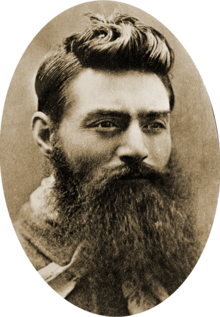
Ned Kelly
| Born |
June 1854 or 1855
Beveridge, Victoria
Australia |
Died
(Executed by hanging for murder) |
11 November 1880 (age 25)
Melborne, Victoria
Australia |
| Occupation |
Bushranger |
| Parents |
John "Red" Kelly
Ellen Kelly (nee Guinn) |
|
Kelly was baptized by an Augustinian priest, Charles O'Hea.
As a boy he obtained basic schooling and once risked his life to save another
boy, Richard Shelton, from drowning. As a reward he was given a green sash
by the boy's family, which he wore under his armour during his final showdown
with police in 1880.
Kelly's family moved to Avenel, near Seymour, where Red
Kelly became noted as an expert cattle-stealer. In 1865 he was convicted
of cattle duffing and imprisoned. Red Kelly died at Avenel on 27 December
1866 shortly after his release from Kilmore gaol. When Red Kelly died he
was survived by his wife and seven offspring, Ned and Dan, James, Mrs Gunn,
Mrs Skillion, Kate and Grace. Several months later the Kelly family acquired
80 acres (320,000 m2) of uncultivated farmland at Eleven Mile Creek near
the Greta area of Victoria, which to this day is known as "Kelly Country".
The Kellys were suspected many times of cattle or horse
stealing, but never convicted. Ned Kelly himself claimed that he had stolen
over 280 horses as a boy. Red Kelly was arrested when he killed and skinned
a calf claimed to be the property of his neighbour. He was found innocent
of theft, but guilty of removing the brand from the skin and given the
option of a twenty-five pound fine or a sentence of six months with hard
labour. Unable to pay the fine, Red served his sentence, which had an ultimately
fatal effect on his health. The saga surrounding Red, and his treatment
by the police, made a strong impression on his son Ned.
In all, eighteen charges were brought against members
of Ned's immediate family before he was declared an outlaw, while only
half that number resulted in guilty verdicts. This is a highly unusual
ratio for the time, and led to claims that Ned's family was unfairly targeted
from the time they moved to northeast Victoria. Perhaps the move was necessary
because of Ellen's squabbles with family members and her appearances in
court over family disputes. Antony O'Brien argued that Victoria's colonial
police practices treated arrest as equivalent to proof of guilt. Further,
O'Brien argued, using the "Statistics of Victoria" crime figures that the
region's or family's or national criminality was determined not by individual
arrests, but rather by the total number of arrests.
Rise to notoriety
Ned's first documented brush with the law was on 15 October
1869 at the age of 14 when he was charged with the assault and robbery
of Ah Fook, a pig and fowl trader from a Chinese camp near Bright. According
to Ah Fook, as he was passing the Kelly house, Ned approached him with
a long bamboo stick, announcing that he was a bushranger and would kill
him if he did not hand over his money. Ned then took him into the bush,
beat him with the stick and stole 10 shillings. According to Ned, his sister
Annie and two witnesses, Bill Skilling and Bill Grey, Annie was sitting
outside the house sewing when Ah Fook walked up and asked for a drink of
water. Given creek water, he abused Annie for not giving him rain water
and Ned came outside and pushed him. Ah Fook then hit Ned three times with
the bamboo stick, causing him to run away. Ah Fook then walked away threatening
to return and burn the house down. Ned did not return until sundown. Historians
find neither account convincing and believe that Ned's account is likely
true up to being hit by Ah Fook but then Ned likely took the stick from
him and beat him with it.
| Ned was arrested the following day for Highway Robbery
and locked up overnight in Benalla. He appeared in court the following
morning but Sergeant Whelan, despite using an interpreter to translate
Ah Fook's account, requested a remand to allow time to find an interpreter.
Ned was held for four days. Appearing in court on 20 October he was again
remanded after the police failed to produce an interpreter. The charge
was finally dismissed on 26 October and Ned was released. Sergeant Whelan
disliked Ned. Three months earlier when he had prosecuted Yeaman Gunn for
possession of stolen mutton, Ned testified that he had sold several sheep
to Gunn that same day. In a controversial judgement, the magistrate found
Gunn guilty and fined him £10. Furious that Ned was not convicted
for the robbery, Whelan now kept a careful watch on the Kelly family and,
according to fellow officers, became "a perfect encyclopedia of knowledge
about them" through his "diligence".
Following his court appearance, the Benalla Ensign reported,
"The cunning of himself [Ned] and his mates got him off", the Beechworth
Advertiser on the other hand reported that "the charge of robbery has been
trumped up by the Chinaman to be revenged on Kelly, who had obviously assaulted
him."[this quote needs a citation] Interestingly, Ah Fook had described
14-year-old Ned as being aged around 20 years. Some 12 months later a reporter
wrote that Ned "gives his age as 15 but is probably between 18 and 20".
Although 5' 8" in height, Ned was physically imposing. When arrested, a
224 pounds (102 kg) trooper was purportedly unable to subdue the then 15-year
old Ned until several labourers ran to assist him and even then Ned had
to be knocked unconscious.
Harry Power
On 16 March 1870, bushranger Harry Power and Ned Kelly
stuck up and robbed Mr M'Bean. Later that year on 2 May, he was charged
with robbery in company and accused of being Power's accomplice. The victims
could not identify Ned, and the charges were dismissed. He was then charged
with robbery under arms, but the principal witness could not be located
and the charges were dismissed. He was then charged a third time, for a
hold-up with Power against a man named Murray. Although the victims for
the third charge were reported to have also failed to identify |
.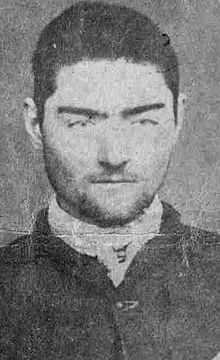
Portrait of Ned Kelly taken by the
Police Photographer at Pentridge
after Ned's transfer from the
Beechworth Gaol in 1873
(State Library of Victoria) |
Ned, they had in fact been refused a chance to identify him
by Superintendents Nicolas and Hare. Instead, superintendent Nicolas told
the magistrate that Ned fit the description and asked for him to be remanded
to the Kyneton court for trial. Instead of being sent to Kyneton, he was
sent to Melbourne where he spent the weekend in the Richmond lock-up before
transferring to Kyneton. No evidence was produced in court and he was released
after a month. Historians tend to disagree over this episode: some see
it as evidence of police harassment; others believe that Kelly’s relatives
intimidated the witnesses, making them reluctant to give evidence. Another
factor in the lack of identification may have been that the witnesses had
described Power's accomplice as a "half-caste". However, superintendent
Nicholas and Captain Standish believed this to be the result of Ned going
unwashed.
Kelly's grandfather, James Quinn, owned a huge piece of
land at the headwaters of the King River known as Glenmore Station, where
Power was ultimately arrested. Following Power's arrest it was rumoured
that Kelly had informed on him and Kelly was treated with hostility within
the community. Kelly wrote a letter to police Sergeant Babington pleading
for his help in the matter. The informant was in fact Kelly's uncle, Jack
Lloyd.
In October 1870, Kelly was arrested again for assaulting
a hawker, Jeremiah McCormack, and for his part in sending McCormack's childless
wife a box containing calves' testicles and an indecent note. This was
a result of a row earlier that day when McCormack accused a friend of the
Kellys, Ben Gould, of using his horse without permission. Gould wrote the
note, and Kelly passed it to one of his cousins to give to the woman. He
was sentenced to three months' hard labour on each charge.
Upon his release Kelly returned home. There he met Isaiah
"Wild" Wright who had arrived in the area on a chestnut mare. While he
was staying with the Kellys, the mare had gone missing and Wright borrowed
one of the Kelly horses to return to Mansfield. He asked Ned to look for
the horse and said he could keep it until his return. Kelly found the mare
and used it to go to Wangaratta where he stayed for a few days but while
riding through Greta on his way home, Ned was approached by police constable
Hall who, from the description of the animal, knew the horse was stolen
property. When his attempt to arrest Kelly turned into a fight, Hall drew
his gun and tried to shoot him, but Kelly overpowered the policeman and
humiliated him by riding him like a horse and driving his spurs into the
back of his legs. Hall later struck Kelly several times with his revolver
after he had been arrested. Ned always maintained that he had no idea that
the mare actually belonged to the Mansfield postmaster and that Wright
had stolen it. After just three weeks of freedom, 16-year-old Kelly, along
with his brother-in-law Alex Gunn, was sentenced to three years imprisonment
with hard labour for "feloniously receiving a horse". "Wild" Wright escaped
arrest for the theft on 2 May following an "exchange of shots" with police,
but was arrested the following day. Wright received only eighteen months
for stealing the horse. After his release from Pentridge Prison in February
1874, Ned allegedly fought and won a bare-knuckled boxing match with 'Wild'
Wright that lasted 20 rounds.
While Kelly was in prison, his brothers Jim (aged 12)
and Dan (aged 10) were arrested by Constable Flood for riding a horse that
did not belong to them. The horse had been lent to them by a farmer for
whom they had been doing some work, but the boys spent a night in the cells
before the matter was cleared.
Two years later, Jim Kelly was arrested for cattle-duffing.
He and his family claimed that he did not know that some of the cattle
did not belong to his employer and cousin Tom Lloyd. Jim was given a five-year
sentence, but as O'Brien pointed out the receiver of the 'stolen stock'
James Dixon was not prosecuted as he was 'a gentleman'.
Shoemaker shop brawl
In September 1877 a drunk Kelly was arrested for riding
over a footpath and locked-up for the night. The next day, while he was
escorted by four policemen, he escaped and ran, taking refuge in a shoemaker's
shop. The police and the shop owner tried to handcuff him but failed. During
the struggle Kelly's trousers were almost ripped off. Trying to get Kelly
to submit, Constable Lonigan, whom Kelly later shot dead, "black-balled"
him (grabbed and squeezed his testicles).[citation needed] During the struggle,
a miller walked in, and on seeing the behaviour of the police said "You
should be ashamed of themselves." The miller then tried to pacify the situation
and induced Kelly to put on the handcuffs.
Kelly said about the incident "It was in the course of
this attempted arrest Fitzpatrick endeavoured to catch hold of me by the
foot, and in the struggle he tore the sole and heel of my boot clean off.
With one well-directed blow, I sent him sprawling against the wall, and
the staggering blow I then gave him partly accounts to me for his subsequent
conduct towards my family and myself."
Legend has it that Kelly told Lonigan that "If I ever
shoot a man, Lonigan, it'll be you!"
In October 1877, Gustav and William Baumgarten were arrested
for supplying stolen horses to Kelly and were sentenced in 1878. Baumgarten
served time in Pentridge Prison, Melbourne.
Following his father's death, Kelly's mother, Ellen, married
a Californian named George King, with whom she had three children. King,
Kelly and Dan Kelly became involved in cattle rustling.
Fitzpatrick incident
On 15 April 1878, Constable Strachan, the officer in charge
of the Greta police station, learned that Kelly was at a certain shearing
shed and went to apprehend him. As lawlessness was rampant at Greta, it
was recognised that the police station could not be left without protection
and Constable Alexander Fitzpatrick was ordered there for relief duty.
He was instructed to proceed directly to Greta but instead rode to the
hotel at Winton, where he spent considerable time. On resuming his journey
he remembered that a couple of days previously he had seen in The Police
Gazette an arrest warrant for Dan Kelly for horse stealing. He went to
the Kelly house to arrest him. This violated the police policy that at
least two constables participate in visits to the Kelly homestead. Finding
Dan not at home, he remained with Mrs Kelly and other family members, in
conversation, for about an hour. Upon hearing someone chopping wood he
went to ensure that the chopping was licensed. The man proved to be William
"Bricky" Williamson, a neighbour, who said that he only needed a licence
if he was chopping on Crown land. Fitzpatrick then observed two horsemen
making towards the house he had just left. The men proved to be the teenager
Dan Kelly and his brother-in-law, Skillion. Fitzpatrick returned to the
house and made the arrest. Dan asked to be allowed to have dinner before
leaving. The constable consented, and took a seat near his prisoner.
In an interview three months before his execution, Kelly
said that at the time of the incident he was 200 miles from home. His mother
had asked Fitzpatrick if he had a warrant and Fitzpatrick said that he
had only a telegram to which his mother said that Dan need not go. Fitzpatrick
then said, pulling out a revolver, "I will blow your brains out if you
interfere." His mother replied, "You would not be so handy with that popgun
of yours if Ned were here." Dan then said, trying to trick Fitzpatrick
"Here he (Ned) is coming along." While he was pretending to look out of
the window for Ned, Dan cornered Fitzpatrick, took the revolver and claimed
that he had released Fitzpatrick unharmed. Kelly denied that Fitzpatrick
could have tried to take liberties with his sister she would not have stood
for it.
Fitzpatrick rode to Benalla where he claimed that he had
been attacked by Ned, Dan, Ellen, their associate Bricky Williamson and
Ned's brother-in-law, Bill Skillion. Fitzpatrick claimed that all except
Ellen had been armed with revolvers and that Ned had shot him in the left
wrist and that Ellen had hit him on the helmet with a coal shovel. Williamson
and Skillion were arrested for their part in the affair. Ned and Dan were
nowhere to be found, but Ellen was taken into custody along with her baby,
Alice. She was still in prison at the time of Ned's execution. (Ellen would
outlive her most famous son by several decades and died aged 95 on 27 March
1923.)
Kelly asserted that he was not present and that Fitzpatrick's
wounds were self-inflicted. Upon what Kelly claimed was Fitzpatrick's false
evidence, his mother, Skillian and Williamson were convicted. A reward
of £100 was offered for Kelly's arrest. Kelly claimed that this injustice
exasperated him, and led to his taking to the bush. Just before Kelly was
taken away from Benalla after the Glenrowan shootout, Senior-constable
Kelly claimed he interviewed him in his cell. The Senior-constable claims
that Kelly admitted to shooting Fitzpatrick.
Trial
At the Benalla Police Court, on 17 May 1878, William Williamson,
alias "Brickey", William Skillion, and Ellen Kelly while on remand, were
charged with aiding and abetting attempted murder. Ellen Kelly, Skillion
and Williamson appeared on 9 October 1878 before Judge Redmond Barry charged
with attempted murder. Despite Fitzpatrick's doctor reporting a strong
smell of alcohol on the constable and his inability to confirm the wrist
wound was caused by a bullet, Fitzpatrick's evidence was accepted by the
police and the judge. They were all convicted on Fitzpatrick's unsupported
evidence. Skillion and Williamson both received sentences of six years
and Ellen three years. Barry stated that if Ned were present he would "give
him 15 years".
Fitzpatrick's legacy is coloured by the fact that he was
later dismissed from the force for drunkenness and perjury and that after
the trial Dr. Nicholson told Fitzpatrick that his wound "was never caused
by a bullet".
Killings at Stringybark Creek
| Dan and Ned Kelly doubted they could convince the police
of their story. Instead they went into hiding, where they were later joined
by friends Joe Byrne and Steve Hart.
The police heard privately that the Kellys were in the
Wombat Ranges at the head of the King River. On Friday 25 October 1878,
two parties of police were secretly despatched, one from Greta, consisting
of five men, with Sergeant Steele in command, and one of four from Mansfield,
with the intention of executing a pincer movement.
Sergeant Kennedy from the Mansfield party set off to search
for the Kellys, accompanied by Constables McIntyre, Lonigan, and Scanlon.
All were in civilian dress. The police set up a camp on an disused diggings
near two miners huts at Stringybark Creek in a heavily timbered area.
About six a.m. on Saturday, Kennedy and Scanlan went down
the creek to explore, and they stayed away nearly all day. It was McIntyre's
duty to cook, and he attended closely to camp duty. During the morning
a noise was heard, and McIntyre went out to have a look, but found nothing.
He fired two shots out of his gun at a pair of parrots. This gunshot, he
subsequently learned, was heard by Kelly, who must have been on the lookout
for the police. At about 5 pm, McIntyre was at the fire making tea, with
Lonigan by him, when they were suddenly surprised with the cry, "Bail up;
throw up your arms."
They looked up, and saw four armed men on foot. Three
carried guns, and Ned Kelly two rifles. Two of the men they did not know,
but the fourth was the younger Kelly. They had approached up the rises
and long grass or rushes had provided them with excellent cover until they
got close. McIntyre had left his revolver at the tent door, and was unarmed.
He therefore held up his hands as directed, and faced them. Lonigan started
for shelter behind a tree, and at the same time put his hand upon his revolver.
Before he had moved two paces, Edward Kelly shot him in the temple. He
fell at once, and as he laid on the ground said, "Oh Christ, I am shot."
He died in a few seconds. Kelly had McIntyre searched, and when they found
he was unarmed, they let him drop his hands. They got possession of Lonigan
and McIntyre's revolvers. Kelly remarked, "What a pity; what made the fool
run?" The men helped themselves to articles from the tent. Kelly talked
to McIntyre, and expressed his wonder that the police should have been
so foolhardy as to look for him in the ranges. He made inquiries about
four men, and said he would roast each of them alive if he caught them.
Steele and Flood were two of the four. He asked McIntyre what he fired
at and said they must have been fools not to suppose he was ready for them.
It was evident that he knew the exact state of the camp, the number of
men, and the description of the horses. He asked where the other two were,
and said he would put a hole through McIntyre if he told a lie. McIntyre
told him and hoped they would not be shot in cold blood. Kelly replied
"No, I am not a coward. I'll shoot no man if he holds up his hands."
One of the gang told McIntyre to take some tea and asked
for tobacco. He gave them tobacco and had a smoke himself. Dan Kelly suggested
that he should be handcuffed, but Ned pointed to his rifle and said, "I
have got something better here. Don't you attempt to go; if you do I'll
track you |
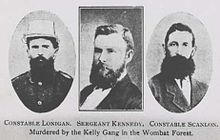
Portraits of Constable Lonigan,
Sergeant Kennedy, Constable Scanlon,
murdered by the Kelly gang
in the Wombat forest
.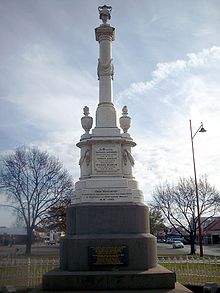
Monument erected in Mansfield, Victoria
in honour of the three policemen
murdered by Kelly's gang, Lonigan,
Scanlon and Kennedy |
to Mansfield and shoot you at the police station." McIntyre
asked whether he was to be shot. Kelly replied, "No, why should I want
to shoot you? Could I not have done it half an hour ago if I had wanted?"
He added, "At first I thought you were Constable Flood. If you had been,
I would have roasted you in the fire." Kelly asked for news of the Sydney
man, the murderer of Sergeant Wallings. McIntyre said the police had shot
him. "I suppose you came out to shoot me?" "No," replied McIntyre, "we
came to apprehend you." "What," asked Kelly, "brings you out here at all?
It is a shame to see fine big strapping fellows like you in a lazy loafing
billet like policemen." He told McIntyre if he was let go he must leave
the police, and McIntyre said he would. The best thing McIntyre could do
was to get his comrades to surrender, for if they escaped he would be shot.
"If you attempt to let them know we are here, you will be shot at once."
McIntyre asked what they would do if he induced his comrades
to surrender. Kelly said he would detain them all night, as he wanted a
sleep, and let them go next morning without their arms or horses. McIntyre
told Kelly that he would induce his comrades to surrender if he would keep
his word, but he would rather be shot a thousand times than sell them.
He added that one of the two was father of a large family. Kelly said,
"You can depend on us." Kelly stated that Fitzpatrick, the man who tried
to arrest his brother in April, was the cause of all this; that his (Kelly's)
mother and the rest had been unjustly "lagged" at Beechworth. Kelly then
caught sound of the approach of Kennedy and Scanlan, and the four men concealed
themselves, some behind logs, and one in the tent. They made McIntyre sit
on a log, and Kelly said, "Mind, I have a rifle for you if you give any
alarm." Kennedy and Scanlan rode into the camp. McIntyre went forward,
and said, "Sergeant, I think you had better dismount and surrender, as
you are surrounded." Kelly at the same time called out, "Put up your hands."
Kennedy appeared to think it was Lonigan who called out, and that a jest
was intended, for he smiled and put his hand on his revolver case. He was
instantly fired at, but not hit; and Kennedy then realised the hopelessness
of his position, jumped off his horse, and said, "It's all right, stop
it, stop it." Scanlan, who carried the Spencer rifle, jumped down and tried
to make for a tree, but before he could unsling his rifle, he was shot
down. A number of shots were fired.
McIntyre found that the men intended to shoot the whole
of the party, so he jumped on Kennedy's horse, and dashed down the creek.
As he rode off he heard Daniel Kelly call out, "Shoot that ******". Several
shots were fired but none reached him. Apparently the rifles were empty
and only the revolvers available, or he would have been hit. He galloped
through the scrub for two miles, and then his horse became exhausted. It
had evidently been wounded. He took off the saddle and bridle, and wounded
from a severe fall during his escape and with his clothes in tatters, he
concealed himself in a wombat hole until dark. At dark, he started on foot,
and walked for an hour with his boots off to make no noise before collapsing
from exhaustion at Bridge's Creek, After a rest, and using a bright star,
and a small compass, he took a westerly course to strike the Benalla and
Mansfield telegraph line and on Sunday afternoon at about 3 pm after a
journey of about 20 miles, he reached John McColl's place, about a mile
from Mansfield. A neighbouring farmer's buggy took him to the police camp
at the township, where be reported all he knew to Sub-Inspector Pewtress.
Two hours or so after McIntyre reported the murder of
the troopers, Sub-Inspector Pewtress set out for the camp, accompanied
by McIntyre and seven or eight townspeople. They had only one revolver
and one gun. They reached the camp with the assistance of a guide, at half-past
2 in the morning. There they found the bodies of Scanlan and Lonigan. They
searched at daylight for the sergeant, but found no trace of him. The tent
had been burnt and everything taken away or destroyed. The post-mortem,
by Dr. Reynolds, showed that Lonigan had received seven wounds, one through
the eyeball. Scanlan's body had four shot-marks with the fatal wound was
caused by a rifle ball which went clean through the lungs. Scanlan was
33, Lonigan 37 years of age. Three additional shots had been fired into
Lonigan's dead body before the men left the camp. The extra shots were
fired so that all of the gang might be equally implicated.
During the search for Kennedy, on 29 October, two relatives
of the Kellys known as "Dummy Wright" and "Wild Wright" were arrested in
Mansfield. Wild Wright had to be threatened with a revolver before he consented
to handcuffs. The two Wrights were brought to the police court and charged
with using threatening language towards members of the search party. The
older brother, Wild Wright, was remanded for seven days and the other released.
No trace had yet been discovered of Kennedy, and the same
day as Scanlan and Lonigan's funeral, another search party was started,
which also failed. At four o'clock on the following Wednesday another party
started, headed by James Tomkins, president of the Mansfield shire, and
Sub-Inspector Pewtress, accompanied by several residents, and on the following
morning the body of the unfortunate sergeant was found by H. G. Sparrow.
The exact place at Germans Creek where this occurred was
identified in 2006. On leaving the scene Ned stole Sergeant Kennedy's handwritten
note for his wife and his gold fob watch. Asked later why he stole the
watch, Ned replied, "What's the use of a watch to a dead man?" Kennedy's
watch was returned to his kin many years later.
In response to these killings, the reward was raised to
£500 and the Victorian parliament passed the Felons' Apprehension
Act which outlawed the gang and made it possible for anyone to shoot them.
There was no need for the outlaws to be arrested or for there to be a trial
upon apprehension. The Act was based on the 1865 Act passed in New South
Wales which declared Ben Hall and his gang outlaws.
Bank robberies
| Following the killings at Stringybark, the gang committed
two major robberies, at Euroa, Victoria and Jerilderie, New South Wales.
Their strategy involved the taking of hostages and robbing the bank safes.
Euroa
At midday on 9 December 1878, Kelly walked into the homestead
of Gooram Gooram Gong Wool station, at Faithful's Creek, owned by Mr Younghusband.
They assured the people that they had nothing to fear and only asked for
food for themselves and their horses. An employee named Fitzgerald, who
was eating his dinner at the time, looked at Kelly and at the large revolver
that he was nonchalantly toying with, and said, "Well, if the gentlemen
want food I suppose they have got to have it." The other three outlaws,
having attended to the horses, joined their chief, and the four imprisoned
the men at the station in a spare building used as a store. No interference
was offered to the women. He assured the male captives time after time
that they had nothing whatever to fear. Late in the afternoon the manager
of the station, Mr Macauley, returned and was promptly bailed up. He told
Ned Kelly that it was not much use coming to that station, because their
own horses were better than any he had. |
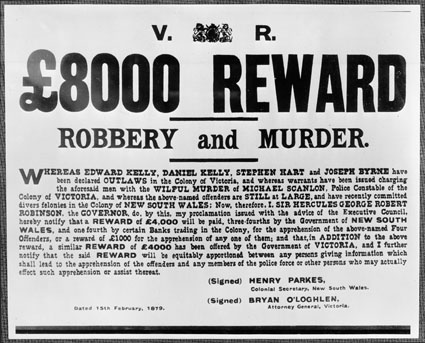
8000 pound reward notice for the
capture of the Ned Kelly gang,
15 February 1879 |
Kelly, however, told him that he did not want horses, only
food for themselves and for their cattle.
Towards evening a hawker named Gloster camped, as usual,
on the station. When he went to the kitchen, a station hand said, "the
Kelly's are here." Gloster replied, "I wish they were, it would be £2,000
in my pocket." Kelly looked up and said, "What is that you say." Gloster,
without waiting to give an explanation, rushed towards the wagon, and Kelly
and Joe Byrne followed. McCauley was for the safety of Gloster and he followed
them. Gloster on reaching his wagon, was making a search for his revolver,
but he was "covered" by the bushrangers, and McCauley cried out, "Look
out Gloster, you will be shot", at the same time appealing to Kelly not
to shoot him. Gloster turned and said, "Who are you?" Kelly replied, "I
am Ned Kelly, son of Red Kelly, as good a blood as any in the land, and
for two pins I would put a match to your wagon and burn it." The stationhands
and Gloster were all placed in the storeroom, under guard. The time passed
quietly until two o'clock in the morning, and at that hour the outlaws
gave a peculiar whistle, and Steve Hart and Joe Byrne rushed from the building.
McCauley was surrounded by the bushrangers and Kelly said, "You are armed,
we have found a lot of ammunition in the house." After this episode the
outlaws retired to sleep.
On the afternoon of the second day, 10 December 1878,
leaving Byrne in charge of the prisoners, the other three started out to
work what they called their new gold mine. First they cut the telegraph
wires, chopping the posts down to make sure, and were careful to rip off
more wire than an ordinary repairer would carry with him. Three or four
railway men endeavoured to interfere, but they too joined the other prisoners
in Younghusband's storeroom. Carrying a cheque drawn by Macauley on the
National Bank for a few pounds, the three bushrangers, all heavily armed,
went to the bank. In the meantime Byrne had apprehended a telegraph-line
repairer, who had begun to make trouble. The others reached the bank after
closing time, travelling in the hawker's cart. Kelly knocked at the door
and persuaded the clerk to open and cash the cheque he had. They balled
up the unwise clerk and his manager, Mr. Scott. The robbers took £700
in notes, gold, and silver. Ned Kelly insisted to the manager that there
was more money there, and eventually compelled him to open the safe, from
which the outlaws got £1,500 in paper, £300 in gold, about
£300 worth of gold dust and nearly £100 worth of silver. The
outlaws were polite and considerate to Mrs. Scott. Mr. Scott, invited the
outlaws to drink whisky with him, which they did. The whole party went
to Younghusband's where the rest of the prisoners were. The evening seems
to have passed quite pleasantly. McCauley remarked to Ned Kelly that the
police might come along, which would mean a fight. Ned Kelly replied, "I
wish they would, of there is plenty of cover here." In the evening tea
was prepared, and at half-past 8 the outlaws warned the prisoners not to
move for three hours, informing them that they were going. Just before
they left Kelly noticed that a Mr. McDougall was wearing a watch, and asked
for it. McDougall replied that it was a gift from his dead mother. Kelly
declared that he wouldn't take it under any consideration, and very soon
afterwards the four of the outlaws left. What is unusual is that these
stirring events happened without the people in the town knowing of anything.
In January 1879 police arrested all known Kelly friends
and purported sympathisers and held them without charge for three months.
This action caused resentment of the government's abuse of power that led
to condemnation in the media and a groundswell of support for the gang
that was a factor in their evading capture for so long.
Jerilderie
Ned Kelly had heard that an individual named Sullivan
had given evidence, and that he had travelled by train from Melbourne to
Rutherglen. The Kelly gang then followed him there, but was told that he
went to Uralla across the border in New South Wales. By the time they got
to Uralla, Sullivan had left for Wagga Wagga. They followed him to Wagga
Wagga but lost sight of him. Kelly thought they he might have travelled
to Hay, so they took off in that direction but later gave up their chase.
On their return home, they passed through Jerilderie, and the gang then
decided to stick up the bank.
At midnight on Saturday 8 February 1879, Ned Kelly, Dan
Kelly, Hart and Byrne surrounded the Jerilderie police barracks. Constables
George Denis Devine and Henry Richards were on duty that night. Hart, in
a loud voice, shouted, "Devine, there's a drunken man at Davidson's Hotel,
who has committed murder. Get up at once, all of you." Richards, who was
sleeping at the rear of the premises, came to the front door. Devine opened
the door, meeting Kelly who told him there was a great row at Davidson's.
Devine approached Kelly, who pointed two revolvers at the policemen, telling
them to hold up their hands. Immediately the police were pounced upon by
the other men and placed in the lock-up cell, and Mrs Devine and children
were put into the sitting-room. Afterwards Mrs Devine, in her nightdress,
was made to deliver up all the firearms. After this the gang went into
the sitting room, where they kept watch till morning.
The next day, Sunday, there was a chapel in the courthouse,
100 yards from the barracks. Mrs Devine's duty was to prepare the courthouse
for mass. She was allowed to do so, but was accompanied by one of the Kellys,
at about 10 am Kelly remained in the courthouse while Mrs Devine prepared
the altar and dusted the forms. When this was done Kelly escorted her back
to the barracks, where the door was closed and the blinds all down. Hart
and Dan Kelly, dressed out in police uniform, walked to and from the stables
during the day without attracting notice.
On Monday morning Byrne brought two horses to be shod,
but the blacksmith thought there was something strange in his manner, so
he noted the horse's brands. About 10 am The Kellys, in company with Constable
Richards, went from the barracks, closely followed on horseback by Hart
and Byrne. They all went to the Royal Hotel, where Cox, the landlord, told
Richards that his companions were the Kellys. Ned Kelly said they wanted
rooms at the Royal, as he intended to rob the bank. Hart and Byrne rode
to the back and told the groom to stable their horses, but not to give
them any feed. Hart went into the kitchen of the hotel, a few yards from
the back entrance to the bank. Byrne then entered the rear of the back,
when he met the accountant, Mr Living, who told him to use the front entrance.
Byrne displayed his revolver and induced him to surrender. Byrne then walked
him and Mackie, the junior accountant, into the bar, where Dan Kelly was
on guard. Ned Kelly secured the bank manager, Mr Tarleton, who was ordered
to open the safes. When this was done, he was put in with the others. All
were liberated at a quarter to three.
The gang took two thousand pounds from the bank. The bushrangers
then went to some of the hotels, treating everyone civilly, and had drinks.
Hart took a new saddle from the saddler's. Several watches were taken,
but afterwards returned. Two splendid police horses were taken, and other
horses were wanted, but the residents claimed that they belonged to women,
and Kelly relented. The telegraph operators were also incarcerated. Byrne
took possession of the office, and overhauled all the telegrams sent that
day. The group left about 7 pm in an unknown direction. The Kellys openly
stated that they had come to shoot Constable Devine, but his wife's entreaties
saved him. Ned Kelly stated that he intended to stick up the Urana coach
and bank. Two policemen and two civilians armed with guns offered to go
in the coach, but the driver declined. The disarmed and unhorsed police
had no other means of following the gang.
Ned Kelly, in company with a Mr Living and Constable Richards
went to the printing office. S. Gill, journalist, when called upon to stand,
ran instead and planted himself in the creek. Richards said, "Mrs Gill,
don't be afraid, this is Kelly." Kelly said, "All I want him for is for
your husband to print this letter, the history of my life, and I wanted
to see him to explain it to him." Living said, "For God's sake, Kelly,
give me the papers, and I will give them to Gill." Later in the day Kelly
relaxed with townspeople at M'Dougall's, and said any one could shoot him,
but then they would kill every inhabitant.
After the manager had been secured, Ned Kelly took Living
back to the bank. and asked him how much money they had. Living admitted
to between £600 and £700, but Kelly replied, "You must have
£10,000". Living then handed him the teller's cash, £691. Kelly
asked if they had more money, and Living answered "No." Kelly tried to
open the safe's treasure drawer, but was told by Living that it contained
nothing of value. Kelly insisted and one of the keys was given to him;
but need the second key. Byrne wanted to break it open with a sledgehammer,
but Kelly got the key from the manager and found £1450. Kelly noticed
a deed-box and was told that it contained a few worthless documents. He
replied that he would burn the contents, but Tarleton convinced him to
take only one document. The group then went to the hotel. Kelly took two
of the party to the back of the hotel, where he made a fire and burned
three or four bank books.
Before leaving, Kelly told the group that when Fitzpatrick,
the Benalla constable, was shot, he was not within 400 miles of Greta.
However, he admitted to stealing 280 horses from Whitty's station and denied
that he had committed any other crime. The horses, he stated, were sold
to Baumgarten. Kelly showed the group his revolvers, and pointed out one
which he had taken from Constable Lonigan, and further stated that he had
shot Lonigan with a worn-out, crooked musket. He asked those present how
they would like detectives pointing revolvers at their mothers and sisters,
threatening to shoot them if they did not say where they were. He blamed
such treatment for turning him against the law. He said that he had come
only to shoot the two policemen, Devine and Richards, calling them worse
than any black trackers, especially Richards, whom he intended to shoot
immediately. Tarleton remarked that Kelly should not blame Richards for
doing his duty. Kelly then replied, "Suppose you had your revolver ready
when I came in, would you not have shot me ?" Mr Tarleton replied "Yes."
"Well," said Kelly, "that's just what I am going to do with Richards—shoot
him before he shoots me." The party then interceded for Richards, but Kelly
said, "He must die." Before leaving Ned Kelly remarked that he had made
a great blunder which would likely lead to their capture.
New South Wales issued rewards totalling £4,000.
The Victorian Government matched that amount, making the total reward for
the Kelly gang £8,000.
Voyage to California
From early March 1879 to June 1880 nothing was heard of
the gang's whereabouts. However, in late March 1879 Ned's sisters Kate
and Margaret asked the captain of the Victoria Cross how much he would
charge to take four or five gentlemen friends to California from Queenscliff.
On 31 March, an unidentified man arranged an appointment with the captain
at the General Post Office to give a definite answer for the cost. The
captain contacted police, who placed a large number of detectives and plain-clothes
police throughout the building, but the man failed to appear. There is
no evidence that Ned's sisters were enquiring on behalf of the gang, and
was reported in the Argus as "without foundation".
In April 1880 a Notice of Withdrawal of Reward was posted
by Government. It stated that after 20 July 1880 the Government would "absolutely
cancel and withdraw the offer for the reward".
Jerilderie letter
Months prior to arriving in Jerilderie, Joe Byrne helped
Ned Kelly dictate a lengthy letter for publication describing his view
of his activities and the treatment of his family and, more generally,
the treatment of Irish Catholics by the police and the English and Irish
Protestant squatters.
The Jerilderie Letter, as it is called, is a document
of 7,391 words and became a famous piece of Australian literature. Ned
Kelly handed it to Mrs. Gill, on Monday 10 February 1879 during the time
when the Kelly gang held up the town of Jerilderie.
Before the Jerilderie Letter, Kelly had posted a 20-page
letter on 16 December 1878 to a member of Parliament, Mr Donald Cameron
M.L.A, stating his grievances, but only a synopsis was published. The letter
highlights the various incidents that led to him becoming an outlaw.
Excerpts of the Jerilderie Letter were published and then
it was concealed until rediscovered in 1930. It was then published in full
by the Melbourne Herald.
The handwritten document was donated anonymously to the
State Library of Victoria in 2000. Historian Alex McDermott stated that
"even now it's hard to defy his voice. With this letter Kelly inserts himself
into history, on his own terms, with his own voice. ... We hear the living
speaker in a way that no other document in our history achieves". Kelly's
language is colourful, rough and full of metaphors; it is "one of the most
extraordinary documents in Australian history".
The National Museum of Australia in Canberra holds publican
John Hanlon's transcript of the Jerilderie Letter.
Murder of Sherritt
| On 26 June 1880 the Felons' Apprehension Act 612 expired,
and the gang's outlaw status their arrest warrants expired with it. While
Ned and Dan still had prior warrants outstanding for the attempted murder
of Fitzpatrick, technically Hart and Byrne were free men although the police
still retained the right to re-issue the murder warrants.
On Friday, 25 June 1880, Dan Kelly and Joe Byrne rode
into the valley known as 'The Woolshed,' where Aaron Sherritt had a small
farm. Ned had decided to rob the banks of Benalla, headquarters of most
of the police engaged in the Kelly hunt. First he planned to kill or capture
the Benalla police in a pitched battle at the small town of Glenrowan,
when they had been lured there by a diversion further along the railway
line.
Aaron Sherritt was to provide the necessary diversion.
Treacherous, brutal, immoral and vain, Sherritt was the most dangerous
of the many police informers. Police money had bought him a thoroughbred
horse, flash clothes, and a fatal arrogance. Spurned as a traitor by Joe
Byrne's younger sister, he had approached Kate Kelly and had been threatened
by an enraged Mrs. Skillion. He had married a 15-year old girl and settled
on his parents' farm to spy for the police and work for the death of his
former friends. He thought that the gang still trusted him although he
had spoken of gaining the £8,000. Four policemen were stationed at
the Sherritt house for protection.
|
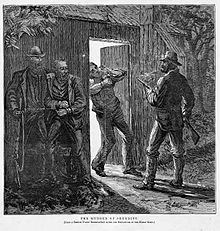
Murder of Sherritt
(State Library of Victoria) |
The gang decided to kill him, while knowing of the protection.
They had watched the hut the previous night and seen Sherritt come to the
door, alone, to talk to Anton Weekes, a German who had a small farm nearby.
The two outlaws captured and handcuffed Weekes, reassuring him that he
would not be hurt if he obeyed them. They pushed him to the back door of
the hut. Joe rapped on the door and then stood back, with Dan in the darkness.
They could hear movement inside. Sherritt's voice asked: 'Who is there?'
Prompted by Joe, the German replied: 'It is me, I have lost my way.' Young
Mrs. Sherritt opened the door. Aaron stood framed in the doorway and began
to joke with Weekes. "You must be drunk, Anton. You know that it's over
that way," laughed Sherritt. As he raised his arm to point the direction,
Byrne fired at point-blank range. Sherritt staggered back bleeding from
a bullet through the chest. Byrne followed him and fired again. Sherritt
died without a word. His wife screamed and ran to cradle his head in her
arms while her mother (Mrs. Barry) asked her son-in-law's killer: 'Why
did you do it, Joe? Why did you do it?' Mrs. Barry knew the Byrne family
well and had been a particular friend of Mrs. Byrne, Joe's mother. "I won't
hurt you, Ma'am," replied the outlaw. 'But that ******* had it coming to
him. He will never put me away again.'
When Weeks had first knocked at the door Constable Duross
had been talking with Sherritt and his wife in the kitchen. He joined the
3 other police men in the bedroom. They remained there while Sherrit was
shot. Byrne told Barry to open the front door of the hut. She did and revealed
Dan Kelly a few feet away. The Sherritt home was a typical 2-room slab
hut of the period. Dan could see through the bedroom and kitchen to Joe
at the back. 'All right police,' he shouted. 'You've been looking for the
Kellys. Well, here we are.' Joe ordered the frightened women to leave the
house. When they had done so the outlaws began shooting into the walls
of the bedroom. The police threw themselves to the floor.
The gang then surrounded the hut, and called upon the
police to surrender, firing eight shots into the house. The police said
they would rather die than surrender. The gang kept the police trapped
for twelve hours, threatening to burn the house down and roast them alive,
but left without doing so.
Glenrowan shootout
| According to Ned Kelly, after shooting Sherritt at Sebastopol,
the gang rode openly through Beechworth to Glenrowan, with the intention
of wrecking any special train bringing additional police to join in their
pursuit. They descended on Glenrowan about 8 am on Sunday 27 June 1880
and took over the township without meeting resistance from the inhabitants.
The gang compelled the line-repairers and others to damage the track. They
selected the first turning after reaching Glenrowan, at a culvert and on
an incline. One rail was raised on each side, and the sleepers were removed.
At 3 o'clock on Monday morning, they gathered their captives (as many as
47) at the hotel. Under duress, drinks were provided to both gang members
and townspeople while a piano played.
The gang members were equipped with armour that repelled
bullets (but left the legs unprotected). The police knew about the armour,
and that the gang had tested it with bullets at ten paces. (The armour
had been made in the district by a man well known to the police, although
the proof was insufficient for a conviction.) Each man's armour weighed
about 44 kilograms (97 lb). All four had helmets. Byrne's was said to be
the best, with the brow reaching down to the nose piece, almost forming
two eye slits. All wore grey cotton coats reaching past the knees over
the armour.
Following the killing of the informer Sherritt, two special
trains had been dispatched from Melbourne carrying police reinforcements
and reporters. The former included native police, whose tracking skills
were a matter of particular concern to Ned Kelly. The Kelly gang's attempt
to derail and ambush the leading train failed because a released hostage,
schoolmaster Thomas Curnow who had convinced Kelly to let him go, stood
on the railway line waving a lantern wrapped in his red scarf. The engine
driver stopped the train short of the broken track and the police disembarked,
to lay siege to the inn at dawn.
According to on-scene reporters from The Argus, the police
and the gang fired at each other for about a quarter of an hour. Then there
was a lull but nothing could be seen for a minute or two because of the
smoke. Superintendent Hare returned to the railway-station with a shattered
left wrist from one of the first shots fired. He bled profusely, but Mr.
Carrington, artist of The Sketcher, stopped the haemorrhage with his handkerchief.
Mr. Hare returned to the battle but he gradually lost so much blood that
he had to be conveyed to Benalla by a special railway engine.
The police, black trackers and others watched the surrounded
hotel throughout the night. At about 5 o'clock in the morning the landlady,
Mrs. Jones, began loudly wailing over the fate of her son, who had been
shot in the back. She came out from the hotel crying bitterly and wandered
into the bush on several occasions. With the assistance of one of the prisoners
she removed her son from the building, and sent him to Wangaratta for treatment.
The firing continued intermittently. Bullets lodged in the station buildings
and the train.
At daybreak police reinforcements arrived from Benalla,
Beechworth, and Wangaratta. Superintendent John Sadleir came from Benalla
with nine more men. Sergeant Steele, of Wangaratta, brought six, for a
total of about 30 men. Before daylight Senior-constable Kelly found a revolving
rifle and a cap lying in the bush, about 100 yards from the hotel. The
rifle was covered with blood and a pool of blood lay near it. They believed
it to belong to one of the bushrangers, hinting that they had escaped.
They proved to be those of Ned Kelly himself. At daybreak the women and
children among the hostages were allowed to depart. They were challenged
as they approached the police line, to ensure that the outlaws were not
attempting to escape in disguise.
Capture
In the early morning light, Kelly then attacked the police
from the rear, dressed in a long grey overcoat and wearing an iron mask.
He was armed only with a revolver. He moved coolly from tree to tree, returning
fire. Sergeant Steele, Senior-constable Kelly and a railway guard named
Dowsett charged him. The latter was only armed with a revolver. They fired
at him with no effect. Sergeant Steele realised that his legs were unprotected
and brought him down with two shots, with Kelly crying, "I am done—I am
done." Kelly howled and swore at the police. Steele seized him, but Kelly
fired again. Kelly gradually became quiet, shot in the left foot, left
leg, right hand, left arm and twice in the region of the groin. But no
bullet had penetrated his armour. He was carried to the railway station,
and placed in a guard's van and then to the stationmaster's office, where
his wounds were dressed by a doctor from Benalla named Nicholson.
Release of hostages
In the meantime the siege continued. The female hostages
confirmed that the three other outlaws were still in the house. Byrne had
been shot while drinking whisky at the bar about half-past 5 am. The remaining
two kept shooting from the rear of the building during the morning, exposing
themselves to the bullets of the police. Their armour protected them. At
10 o'clock a white flag or handkerchief was held out at the front door,
and immediately afterwards about 30 male hostages emerged, while Kelly
and Hart were defending the back door. They were ordered to lie down and
were checked, one by one. Two brothers named M'Auliffe were arrested as
Kelly sympathisers.
Conflagration
At 2 pm a 12 pound cannon and a company of militia were
sent up by a special train. By afternoon, the shooting from the hotel had
ceased. The police leader, Superintendent Sadleir, decided to set fire
to the hotel and received permission from the Chief Secretary, Robert Ramsay.
At 2:50 pm a final volley |
.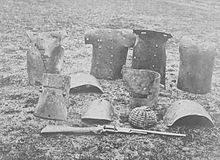
Dan Kelly's and Steve Hart's
armour recovered from the hotel
after it was burnt.
State Library of Victoria
.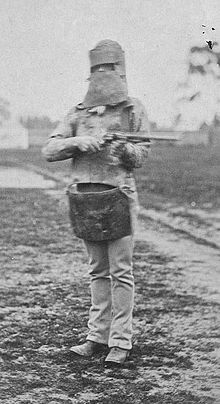
Photograph taken on 5 July 1880
of a policeman equipped in the
Kelly armour.
State Library of Victoria
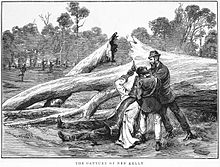
Sgt Steele and railway guard Dowsett
captures Ned Kelly
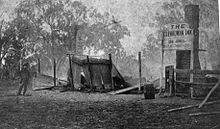
Photograph of Jones Hotel burned down
|
was fired into the hotel, and under cover of the fire, Senior-constable
Charles Johnson, of Violet Town, placed a bundle of burning straw at the
hotel's west side. As the fire took hold, the police began to close in
on the building. Mrs. Skillion and Kate Kelly appeared on the scene at
this juncture. The former endeavoured to make way to her brothers, declaring
she would rather see them burned than shot by the police. The police, however,
ordered her to stop.
A light westerly wind carried the flames from the straw
underneath the wall and into the hotel, and the building's calico lined
floor allowed the fire to spread rapidly. Father Gibney, vicar-general
of Western Australia, entered the burning structure. He discovered the
bodies of Dan Kelly and Steve Hart. He stated that based on their position,
they must have killed one another. The exact cause of their death, whether
in battle or by suicide was never determined.
Hostage Martin Cherry was found dying from a groin wound
in the outhouse or kitchen immediately behind the main building. He was
promptly taken from the burning hotel and laid on the ground, where Father
Gibney administered the last sacrament. Cherry was insensible, and barely
alive. He succumbed within half an hour. He was fortunate to not have burned
alive. He seems to have been shot by the attacking force, of course unintentionally.
The unmarried Cherry was an old platelayer of the district who resided
about a mile from Glenrowan. He was born at Limerick, Ireland and was about
58 years old.
All that was left standing of the hotel was the lamp-post
and the signboard.
A man named Rawlins, a reporter with a newspaper at Benalla,
was shot and wounded. A boy and girl, the children of Mrs. Jones, were
shot. The young girl survived, but the boy later died in hospital the following
day. A black tracker also had a narrow escape with a ball grazing his forehead.
The Royal Commission recommended that Superintendent Hare
be allowed to retire from the force, as though he had attained the age
of 55 years, and that, owing to his wound, he receive an additional allowance
of £100 per annum. One of the black trackers and several hostages
were also shot, two fatally.
The body of Joe Byrne was strung up in Benalla as a curiosity.
Byrne's friends asked for the body but it was instead secretly interred
at night by police in an unmarked grave in Benalla Cemetery
The charred remains of Dan Kelly and Hart were taken to
Mrs. Skillion's place at Greta. They were then placed into very expensive
coffins, the lid of the one was lettered "Daniel Kelly, died 28th June
1880, aged 19 years" and the other "Stephen Hart, died 28th June 1880,
aged 21 years." They were buried in unmarked graves by their families in
Greta Cemetery 30 km (19 mi) east of Benalla.
Statements to the press
| "I was going down to meet the special train with some
of my mates, and intended to rake it with shot; but it arrived before I
expected, and I then returned to the hotel. I expected the train would
go on, and I had the rails pulled up so that these ****** blacktrackers
might be settled. I do not say what brought me to Glenrowan, but it seems
much. Anyhow I could have got away last night, for I got into the bush
with my grey mare, and lay there all night. But I wanted to see the thing
end. In the first volley the police fired I was wounded on the left foot;
soon afterwards I was shot through the left arm. I got these wounds in
front of the house. I do not care what people say about Sergeant Kennedy's
death. I have made my statement of the affair, and if the public don't
believe me I can't help it; but I am satisfied it is not true that Scanlan
was shot kneeling. He never got off his horse. I fired three or four shots
from the front of Jones's hotel, but who I was firing at I do not know.
I simply fired where I saw police. I escaped to the bush, and remained
there overnight. I could have shot several constables if I liked. Two passed
close to me. I could have shot them before they could shoot. I was a good
distance away at one time, but came back. Why don't the police use bullets
instead of duck shot? I have got one charge of duck-shot in my leg. One
policeman who was firing at me was a splendid shot, but I do not know his
name. I daresay I would have done well to have ridden away on my grey mare.
The bullets that struck my armour felt like blows from a man's fist. I
wanted to fire into the carriages, but the police started on us too quickly.
I expected the police to come." Inspector Sadleir.—You wanted, then, to
kill the people in the train ?" Kelly. —"Yes, of course I did; God help
them, but they would have got shot all the same. Would they not have tried
to kill me?
Ned Kelly
|
"The hotel was surrounded by police and black trackers,
who kept up a continuous firing at the hotel building. It was a futile,
as well as cruel, business, because the place was full of the Kellys' prisoners
as anyone could tell by the awful screams. I stopped as much of the shooting
as I could and did none myself except to let go a couple of revolver shots
at two of the bushrangers who walked on to the verandah with their armour
on and fired at the police. I knew about this armour, and it was that knowledge
that was Ned Kelly's downfall."
"The firing went on all night. Some of the people from,
the hotel did get away, but they had to run fearful risks of being shot
by the police and trackers some of whom, crazy with excitement would have
blazed away at anything they saw. There seemed to be no system, no organisation
or direction about the attack. It was all fearfully bungled. A. determined
rush by a few trusty men would have settled the whole business. This was
suggested but turned down because of the likelihood of lives being lost.
There was not much chance of that. And anyway, it was war, and lives were
being lost in the hotel – the lives of non-combatants. But the officer
in charge had to have his way."
"All that night I did little. I was waiting for Ned, principally.
I wanted to make sure of him; and I had a kind of inspiration that I should
see him before it was all over. "Now, as I told you, I knew about the armour
that the outlaws were wearing that night -for the first and last time,
and I knew that a bullet would have to be most correctly aimed to disable
one of them. Anyone who has shot in the dark knows how difficult it is
to pick ap the sights of a rifle, even with something light in front of
the object aimed at. It might have been possible to have hit one of the
outlaws in the head through the slot in the headpiece that they used to
see through, but it would have been mighty uncertain at night with the
man moving.
"I had thought all this over before, many a time. I one
day remembered haying read the story of how a notorious American outlaw,
who for a long time had appeared to lead a charmed life, but eventually
been shot dead by the brother of a man he had murdered, and who had used,
not a rifle, but a double-barrelled gun, double loaded with buckshot Also,
I remembered reading somewhere that it was the practice to use shotguns
and buckshot against train robbers in the States. "Buckshot is not known
here. But the big leaden pellets known as "swan drops" are. And I laid
in a stock of these. Oh the night of the battle, as I lay waiting for an
opportunity to do something useful, that old gun that I have just put away
– it was new then was lying by my side, well charged with the little bullets.
"It was dawn when a fresh outbreak of firing, accompanied
by cries and shouts, announced some new development in the proceedings,
the firing having for some time slackened down. Looking towards the house,
I saw in the dim grey, light a spectral sort of figure that looked human,
as to its clothes, but altogether inhuman as to its shape and general appearance.
It came forward slowly, peppered by all who saw it, and firing back from
what appeared to be a big revolver, held tightly against the breast. Regarding
not at all the heavy fire that was directed towards it from all quarters,
the strange figure, enveloped in a huge overcoat, strode slowly on. I had
already recognised the unaccustomed sound of metallic impact of bullets
upon iron, and whilst the men in front of me were yelling, 'Look out! It's
the devil'. 'You can't kill it!' and things like that, I realised that
at last my chance was coming. Because the big, weird figure was coming
straight for me!"
"'Was it fate!' I wondered. 'Was this Ned, come to settle
the affair of our vendetta in person?' I will not deny that I got a bit
excited, or that I felt a creepy feeling about the roots of my hair. It
was a cold morning, and I was chilled with the long night of it, I know
I shivered when I saw that ghostly apparition stand behind the lower part
of a fallen tree, and quietly proceed to take pot shots at two or three
of us with the queer-looking weapon that it carried. Once this weapon ran
empty, and the spectre calmly reloaded it from the bag that was over its
shoulders. Then it started to shoot again. I fired at the headpiece with
my revolver, but the mark was small, and my hand was not quite steady,
and I do not know if I hit the thing at all – certainly I did not hit the
slit in the top of it that I aimed at But the man in the headpiece took
no notice except to take steady aim at me and fire again. I felt the breath
of the bullet. I tried another pistol shot, but just aimed at the main
bulk of the figure. I heard the ball strike the iron armour, and that was
all. There were three or four shooting at the apparition, but with no effect
at all, though it was close to us."
"Then, in the gathering daylight, I saw my chance. The
tree trunk behind which Ned Kelly was standing. I was now certain that
I had to do with that redoubtable chieftain himself rose in a sloping fashion
from the ground, and at its upper extremity left an open space beneath
of about 2ft. In the growing light of the dawn I noticed, beneath the tree
trank, the outlaw's legs. They were plainly visible, and unprotected by
armour. "I win, Ned" was the fierce thought that surged through me as I
raised the shot-gun, lying over on my left side to do it. "It was as though
I had spoken aloud. For at that instant I heard the outlaw make an exclamation
inside his great clumsy helmet, and when I put my fingers on the triggers
of the gun he was taking a very careful aim at me." 'Would he disable me
before I could fire?" This was the one thought I had. It all passed like
lightning. Instinctively I rolled over a little – just as he fired and
missed. Then, half raising myself, I fired the right barrel of my gun point
blank under the log – straight at his legs. I heard him give an exclamation
as though of pain, and waited a second to see if be would fall, But he
stood firm, and leaning against the log for support, prepared to take aim
again. "I fired the left barrel as quickly as I knew how, and prepared
to dodge behind the tree on my left, and fight the matter out with my revolver.
But there was no need. No sooner had the smoke of the gun cleared away
than I saw the outlaw's pistol hand drop. He staggered, and then, with
a cry of "I'm done for!" that sounded strange and hollow in the cylindrical
iron helmet, fell with a crash behind the stump. "Three or four rushed
to him. I was the first to reach him, and to lift the helmet off. "So,
I've got you at last, Ned" as his eyes met mine. "Yes; you've done for
me" he moaned. "Don't let them hurt me!"
List of victims killed or wounded
| Name |
Injury |
Date |
| Constable Fitzpatrick |
wounded |
15 April 1878 |
| Sergeant Michael Kennedy |
shot dead |
26 October 1878 |
| Constable Scanian |
shot dead |
26 October 1878 |
| Constable Lonigan |
shot dead |
26 October 1878 |
| Aaron Sherritt |
shot dead |
26 June 1880 |
| Martin Cherry |
shot dead |
28 June 1880 |
| John Jones (11yrs) |
shot (died) |
29 June 1880 |
| C.C. Rawlins |
wounded |
28 June 1880 |
| Superintendent Hare |
wounded |
28 June 1880 |
| Martha Jones (14yrs) |
wounded |
28 June 1880 |
Trial
| Ned Kelly survived to stand trial on 19 October 1880,
at Melbourne before Irish-born Justice Sir Redmond Barry. Mr. Smyth and
Mr. Chomley appeared for the crown, and Mr. Bindon for the prisoner.] The
trial was adjourned to the 28th, where Kelly was presented on the charge
of the murder of Sergeant Kennedy, Constable Scanlan and Lonigan, the various
bank robberies, the murder of Sherritt, and resistance to the police at
Glenrowan, together with a long catalogue of minor charges. He was convicted
of the wilful murder of Constable Lonigan and was sentenced to death by
hanging by Justice Barry. Several unusual exchanges between the prisoner
Kelly and the judge included the Judge's customary words "May God have
mercy on your soul", to which Kelly replied "I will go a little further
than that, and say I will see you there when I go". At Ned's request, his
picture was taken and he was granted farewell interviews with family members.
His mother's last words to Ned were reported to be "Mind you die like a
Kelly".
Death
He was hanged on 11 November 1880 at the Melbourne Gaol.
Kelly's gaol warden wrote in his diary that when Kelly was prompted to
say his last words, the prisoner opened his mouth and mumbled something
that he could not hear.
The Argus reported that Mr. Castieau, the governor of
the gaol, informed the condemned man that the hour of execution had been
fixed at ten o'clock. Kelly simply replied "Such is life." His leg-irons
were removed, and after a short time he was marched out. He was submissive
on the way, and when passing the gaol's flower beds, he remarked "what
a nice little garden," but said nothing further until reaching the Press
room, where he remained until the arrival of chaplain Dean Donaghy.
The Argus reported that Kelly intended to make a speech,
but he merely said, "Ah, well, I suppose it has come to this," as the rope
was being placed round his neck.
Although the exact number is unknown, it is estimated
that a petition to spare Kelly's life attracted over 30,000 signatures.
Reward
There was considerable controversy over the division of
the £8,000 (A$400,000 in 2008 dollars) reward. Most commentators
complained that Curnow should have received more while many of the police
deserved less. Public opposition was such that Superintendent Hare and
Sub-inspector O’Connor, who was in charge of the black trackers, declined
to collect their shares of £800 and £237 respectively.
Despite being suspended for cowardice at Glenrowan, Superintendent
Hare was allocated the largest share while Thomas Curnow, who alerted police
to the ambush, thus saving many lives, received £550. Seven senior
police officers received from £165 to £377 each, seven constables
£137, Mr. C. C. Rawlins (civilian volunteer) £137, one constable
£125, 15 constables £115, the three train engineers £104,
one detective £100, one senior constable £97, the train driver,
fireman and guard £84 each, assistant engine fireman £69, assistant
engine driver £68, one senior constable £48, 14 constables
£42 each and Messrs Cheshire and Osborne, £25 each. Nine civilians,
13 constables and two police agents applied for a share of the reward but
were rejected. The board acknowledged that some who received nothing deserved
a share but adherence to the terms of the proclamation precluded rewarding
them. Four members of the media had accompanied the police and the board
stated that, had they applied for a share, it would have been approved.
Seven native trackers also received £50 each although
the board deemed it undesirable to "place any sum of money in the hands
of persons unable to use it" and recommend that "the sums set opposite
the names of the black trackers be handed to the Queensland and Victorian
Governments to be dealt with at their discretion".
Armour
The gang's armour was made of iron a quarter of an inch
thick, and consisted of a long breast-plate, shoulder-plates, back-guard,
and helmet. The helmet resembled a nail can without a crown, and included
a long slit for the eyes. The suits' separate parts were strapped together
on the body while the helmet was separate and sat on the shoulders, allowing
it to be removed easily.
Ned Kelly's armour weighed 44 kilograms (97 lb). His suit
was the only one to have an apron at the back, but all four had front aprons.
Padding is only known from Ned's armour and it is not clear if the other
suits were similarly padded. Ned wore a padded skull cap and his helmet
also had internal strapping so that his head could take some of the weight.
After the shootout there were five bullet marks on the helmet, three on
the breast-plate, nine on the back-plate, and one on the shoulder-plate.
All the men wore dustcoats over the armour.
The manufacture of the four suits occupied four or five
months. Two stolen circular saws and iron tacks were tried and found not
to be bulletproof. Mould boards for plough shares were ultimately adopted.
It was likely that the first suit made was defective, and was therefore
discarded.
About April 1880, the police learned of the theft of mould
boards from five farmers in the vicinity of Greta and Oxley by the Kelly
gang. About a month later the secret agent known as "diseased stock" wrote
a letter to the assistant commissioner intimating that the object of the
outlaws in stealing the mould-boards was to manufacture armour. His message
was an important one: "Missing portions of cultivators are being worked
as jackets and fit splendidly. Tested previous to using, they can withstand
a bullet at 10 yards. A breakout may be anticipated as feed is getting
very scarce. Five are now bad ... other animals are, I fear, diseased."
One of the farmers later identified some of the plates by marks on them.
The Victorian Police were told about the armour three
times by informants, but Hare and Sadleir both dismissed the information
as "nonsense" and "an impossibility". None of the police realised the gang
were wearing armour until Ned fell. The police even questioned whether
he was human. Constable Arthur, who was closest, thought he was a "huge
blackfellow wrapped in a blanket", Someone said, "He is a madman!" Dowsett
said.
"He is the devil!" Sergeant Kelly exclaimed, "Look out, boys, he is the
bunyip!" Constable Gascoigne, who recognised Ned's voice, told Superintendent
Sadleir he had "fired at him point blank and hit him straight in the body.
But there is no use firing at Ned Kelly; he can't be hurt". Although aware
of the information supplied by the informant prior to the siege, Sadleir
later wrote that even after Gascoigne's comment "no thought of armour"
had occurred to him.
Following the siege of Glenrowan the media reported the
events and use of armour around the world. The gang were admired in military
circles and Arthur Conan Doyle commented on the gang's imagination and
recommended similar armour for use by British infantry. The police announcement
to the Australian public that the armour was made from ploughshares was
ridiculed, disputed, and deemed impossible even by blacksmiths.
There was considerable debate over whether to destroy
the armour, but all four disassembled suits were eventually stored in Melbourne.
Hare gave Ned Kelly's armour to Sir William Clarke, and it was later donated
to the State Library of Victoria. Joe Byrne's was kept by Hare and now
belongs to his descendants. Dan Kelly and Steve Hart's are still owned
by the Victorian Police force. As no effort was made to maintain the armour's
integrity while stored, the suits were reassembled by guesswork. In 2002
several parts were identified from photographs taken shortly after the
siege and reunited with their original suits. The State Library of Victoria
was able to exchange Steve Hart's breastplate for Ned Kelly's, making Kelly's
suit currently the most original. In January 2002 all four suits were displayed
together for an exhibition in the Old Melbourne Gaol.
According to legend the armour was made on a Stringybark
log by the gang themselves. Due to the quality of the workmanship and the
difficulties involved in forging, historians and blacksmiths originally
believed the armour could only have been made by a professional blacksmith
in a forge. A professional blacksmith would have heated the steel to over
1,000 °C (1,830 °F), before shaping it. A bush forge could only
reach 750 °C (1,380 °F) which would make shaping the metal very
difficult. In 2003 Byrne's suit of armour was disassembled and tested by
ANSTO at the Lucas Heights nuclear reactor in Sydney to determine how the
armour was made and what temperatures were involved. The results indicated
that the heating of the metal was "patchy". Some parts had been bent cold
while other |
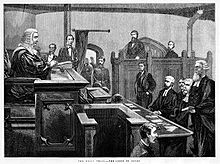
The trial of Ned Kelly
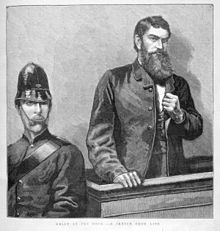
Kelly in the dock
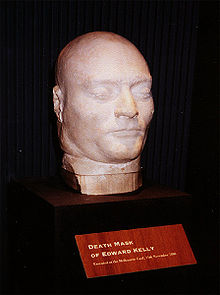
Ned Kelly's death mask in the
Old Melbourne Gaol
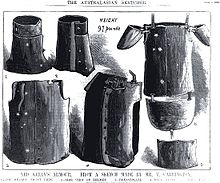
Ned Kelly's armour, from an
1880 illustration
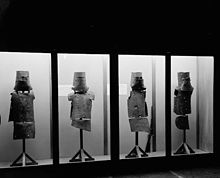
Kelly gang armour on display at
Old Melbourne Gaol. Ned Kelly's
apron is on the far right, and
Ned's helmet, breastplate and rifle
is 3rd from the left
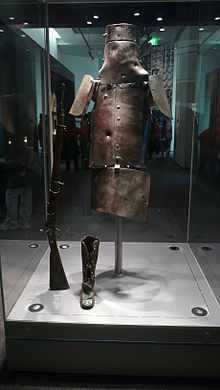
Ned Kelly's armour on display in
the State Library of Victoria
The apron, and one shoulderplate
are not Ned's and comes from either
Dan Kelly's or Steve Hart's armour.
|
parts had been subjected to extended periods in a heat source
of not much more than 700 °C (1,292 °F), which is consistent with
the bush forge theory. The quality of forging was also determined to be
less than believed, and it was considered unlikely to have been done by
a blacksmith. The bush forge is now widely accepted. After heating, the
mould boards were likely beaten straight over a green log before being
cut into shape and riveted together to form each individual piece.
The Hobart Mercury reported that Glenrowan district blacksmith
Joe Grigg had made the armour from parts of ploughs and harvesting machines
while watched by Ned and Dan Kelly. Ned paid for Grigg's work in gold sovereigns.
Grigg immediately told the authorities about it and was told to keep the
cash as he had earned it honestly. This information did not become known
until Grigg's death in 1934 as authorities apparently did not want details
known to the public and, apart from its mention in Grigg's 1934 obituary,
the story remained relatively unknown.
Remains and graves
In line with the practice of the day, no records were
kept regarding the disposal of an executed person's remains. Kelly was
buried in the "old men's yard", just inside the walls of Old Melbourne
Gaol.
Dissection
A newspaper reported that Kelly's body was dissected by
medical students who removed his head and organs for study. Dissection
outside of a coronial enquiry was illegal. Public outrage at the rumour
raised real fears of public disorder, leading the commissioner of police
to write to the gaol's governor, who denied that a dissection had taken
place. His head was allegedly given to phrenologists for study, then returned
to the police, who used it for a time as a paperweight.
Grave robbery
In 1929, Melbourne Gaol was closed for renovation, and
the bodies in its graveyard were uncovered during demolition works. During
the recovery of the bodies, spectators and workers stole skeletal parts
from a grave marked with an arrow and the initials "E. K."[81] in the belief
they belonged to Kelly. The site foreman, Harry Franklin, retrieved the
skull and gave it to the police. As no provision had been made for the
disposal of the remains, Franklin had the bodies reburied in Pentridge
prison at his own expense. The skull which had been stored at the Victorian
Penal Department was taken to Canberra for research by thie first director
of the Australian Institute of Anatomy (Sir Colin Mackenzie) in 1934. For
a period of time it was lost, but was later found while cleaning out an
old safe in 1952. In 1971, the Institute gave it to the National Trust..
Theft of skull
This skull was displayed at the Old Melbourne Gaol until
it was stolen in December 1978. An investigation in 2010 proved that the
displayed skull was in fact the one recovered in April 1929. Tom Baxter,
a farmer from West Australia, claimed he had the skull stolen in 1978 but
refused to hand it over for identification or burial. Despite attempts,
the police were unable to locate the stolen skull. The skull did not match
photographs of the stolen skull, and a facial reconstruction based on a
cast made from the skull in Baxter's possession did not resemble Kelly,
but does resemble the death mask of Ernest Knox, who was executed in 1894
for murder. If this was the skull stolen in 1978, it meant that Kelly's
skull was on display originally but was taken off display at some time
and replaced with Knox's skull.
On 9 March 2008 it was announced that Australian archaeologists
believed they had found Kelly's grave on the site of Pentridge prison.
The bones were uncovered at a mass grave and Kelly's are among those of
32 felons who had been executed by hanging. Jeremy Smith, a senior archaeologist
with Heritage Victoria said, "We believe we have conclusively found the
burial site but that is very different from finding the remains." Ellen
Hollow, Kelly's 62-year-old grand-niece, offered to supply her own DNA
to help identify Kelly's bones.
Historical and forensic investigation of remains
On the anniversary of Kelly's hanging, 11 November 2009,
Tom Baxter handed the skull in his possession to police and it was historically
and forensically tested along with the Pentridge remains. The skull was
compared to a cast of the skull that had been stolen from the Old Melbourne
Gaol in 1978 and proved to be a match. The skull was then compared to that
in a newspaper photograph of worker Alex Talbot holding the skull recovered
in 1929 which showed a close resemblance. Talbot was known to have taken
a tooth from the skull as a souvenir and a media campaign to find the whereabouts
of the tooth led to Talbot's grandson coming forward. The tooth was found
to belong to the skull confirming it was indeed the skull recovered in
1929. The skull was next compared to the death masks of those executed
at Old Melbourne Gaol which eliminated all but two. The two were those
of Kelly and Frederick Deeming who had been executed in 1892 and buried
alongside Kelly, both were a close match. The death masks and skull were
then scanned to provide 3D images which showed that the skull was a match
for Deeming. This proved to be a problem as Deeming's labelled skull cap
was in storage. Both the skull and Deeming's skull cap were DNA tested
and compared to that of Leigh Olver, great-grandson of Kelly's mother Ellen
by her second husband George King, with no match being found. It is now
accepted that the skull recovered in 1929 and later displayed in the Old
Melbourne Gaol was not Kelly's. It is likely the skull belongs to Deeming
and that what was thought to be Deeming's skull cap was mislabelled and
actually belongs to someone else.
Forensic pathologists also examined the bones from Pentridge,
which were much decayed and jumbled with the remains of others, making
identification difficult. The collar bone was found to be the only bone
that had survived in all the skeletons and these were all DNA tested against
that of Leigh Olver. A match to Kelly was found and the associated skeleton
turned out to be one of the most complete. Kelly's remains were additionally
identified by partially healed foot, wrist bone and left elbow injuries
matching those caused by the bullet wounds at Glenrowan as recorded by
the Gaol surgeon in 1880 and by the fact that his head was missing, likely
removed for phrenological study. A section from the back of a skull (the
occipital) was recovered from the grave that bore saw cuts that matched
those present on several neck vertebrae indicating that the skull section
belonged to the skeleton and that an illegal dissection had been performed.
In August 2011, scientists publicly confirmed a skeleton
exhumed from the old Pentridge Prison's mass graveyard was indeed Kelly's,
after comparing the DNA to that of Leigh Olver. The DNA matching was based
on mitochondrial DNA (HV1, HV2). This is indicative of Mr Kelly's maternal
line. The investigating forensic pathologist has indicated that no adequate
quality somatic DNA was obtained that would enable a y-DNA profile to be
determined. This may be attempted at a later date. A y-DNA profile would
enable Mr Kelly's paternal genetic genealogy to be determined with reference
to the data already existing in the Kelly y-DNA study (see this page).
The skeleton was missing most of its skull, the whereabouts of which are
unknown.
Final burial
On 1 August 2012 the Victorian government issued a license
for Kelly's bones to be returned to the Kelly family, who made plans for
their final burial. They also appealed for the person who possessed Kelly's
skull to return it.
On 20 January 2013, Kelly's descendants granted Kelly's
final wish, and buried his remains within consecrated ground at Greta cemetery,
near his mother's unmarked grave. A piece of Kelly's skull was also buried
with his remains and was surrounded by concrete to prevent looting. The
burial followed a Requiem Mass that was held on 18 January 2013 at St Patrick's
Catholic Church in Wangaratta.
Aftermath and lessons
After Ned Kelly's death, the Victorian Royal Commission
(1881–83) investigation of the Victorian Police Force led to many changes
to policing. The Commission took 18 months and its findings put many of
the police involved in the Kelly hunt in a less-than-favourable light,
yet it did not excuse or sanction the actions of the Kelly Gang. The Commission's
work led to reprimands, demotions, or dismissal for a number of members
of the Victorian police, including senior staff.
Writers such as Boxhall, The Story of Australian Bushrangers
(1899) and Henry Giles Turner, History of the Colony of Victoria (1904)
dismiss the Kelly Outbreak as simply a spate of criminality.[citation needed]
Several police writers of the time such as Hare and Penzig (1988) wrote
legitimising narratives about law and order and moral justification.
Others, commencing with Kenneally (1929), McQuilton (1979)
and Jones (1995), perceived the Kelly Outbreak and the problems of Victoria's
Land Selection Acts post-1860s as interlinked. McQuilton identified Kelly
as the "social bandit" who was caught up in unresolved social contradictions—that
is, the selector-squatter conflicts over land—and that Kelly gave the selectors
the leadership they lacked. O'Brien (1999) identified a leaderless rural
malaise in Northeastern Victoria as early as 1872–73, around land, policing
and the Impounding Act.
Though the Kelly Gang was destroyed in 1880, for almost
seven years a serious threat of a second outbreak existed because of major
problems around land settlement and selection.
McQuilton suggested that two police officers involved
in the pursuit of the Kelly Gang – John Sadleir, author of Recollections
of a Victorian Police Officer, and Inspector W.B. Montford – averted the
Second Outbreak by coming to understand that the unresolved social contradiction
in Northeastern Victoria was about land, not crime, and by their good work
in aiding small selectors.
Legacy
November 2007 auction
On 13 November 2007, a weapon claimed to be Constable
Fitzpatrick's service revolver was auctioned for approximately $70,000
in Melbourne and is now located in Westbury, Tasmania. The vendor's representative,
Tom Thompson, claimed that the revolver was left by Constable Fitzpatrick
at the Kelly house after the melee in 1878, given to Kate Kelly (outlaw),
and then (much later) found in a house or shed in Forbes, New South Wales.
According to press reports in the days following the auction,
firearms experts assessed the revolver as being of a design (a copy of
an English Webley .32 revolver) not manufactured until 1884, well after
the claimed provenance had the weapon changing hands from Constable Fitzpatrick
to the Kellys. In addition, a stamp on the gun which the auction catalogue
interpreted as R*C, an indication that the revolver was of the Royal Constabulary,
was instead read as a European manufacturer's proof mark.[citation needed]
Further, evidence by Constable Fitzpatrick said that when he left the Kelly
homestead after the incident, he had his revolver and handcuffs.(Cited
in Keith McMenomy (1984), p. 69.)
Headstone
During the Great Depression the Bayside City council built
bluestone walls to protect local beaches from erosion. The stones were
taken from the outer walls of the Old Melbourne Gaol and included the "headstones"
of those executed and buried on the grounds. Most, including Kelly's, were
placed with the engravings (initials and date of execution) facing inwards.
Cultural effect
One of the gaols in which Kelly was incarcerated has become
the Ned Kelly Museum in Glenrowan, Victoria, and many weapons and artefacts
used by him and his gang are on exhibit there. After his death, Kelly became
part of Australian folklore, and the subject of a large number of books
and several films. The Australian term "as game as Ned Kelly" is a common
expression.
Films included the first feature film, The Story of the
Kelly Gang (Australia, 1906), another with Mick Jagger in the title role
(1970), and more recently Ned Kelly (2003) starring Heath Ledger, Orlando
Bloom and Geoffrey Rush. A TV mini series of four episodes The Last Outlaw
(1980) highlighted the plight of the selector and the social conflicts
and battles between selector and squatters. During the 1960s, Ned Kelly
graduated from folk lore into the academic arena. His story and the social
issues around land selection, squatters, national identity, policing and
his court case are studied at universities, seminars and lectures.
Political icon
In the time since his execution, Ned Kelly has been mythologised
among some into a Robin Hood, a political revolutionary and a figure of
Irish Catholic and working-class resistance to the establishment and British
colonial ties.[100] It is claimed[by whom?] that Kelly's bank robberies
were to fund the push for a "Republic of the North-East of Victoria", and
that the police found a declaration of the republic in his pocket when
he was captured, which led to his status as an icon for some Australian
republicans.
Here
is a documentary of searching for the facts on Ned Kelly
|